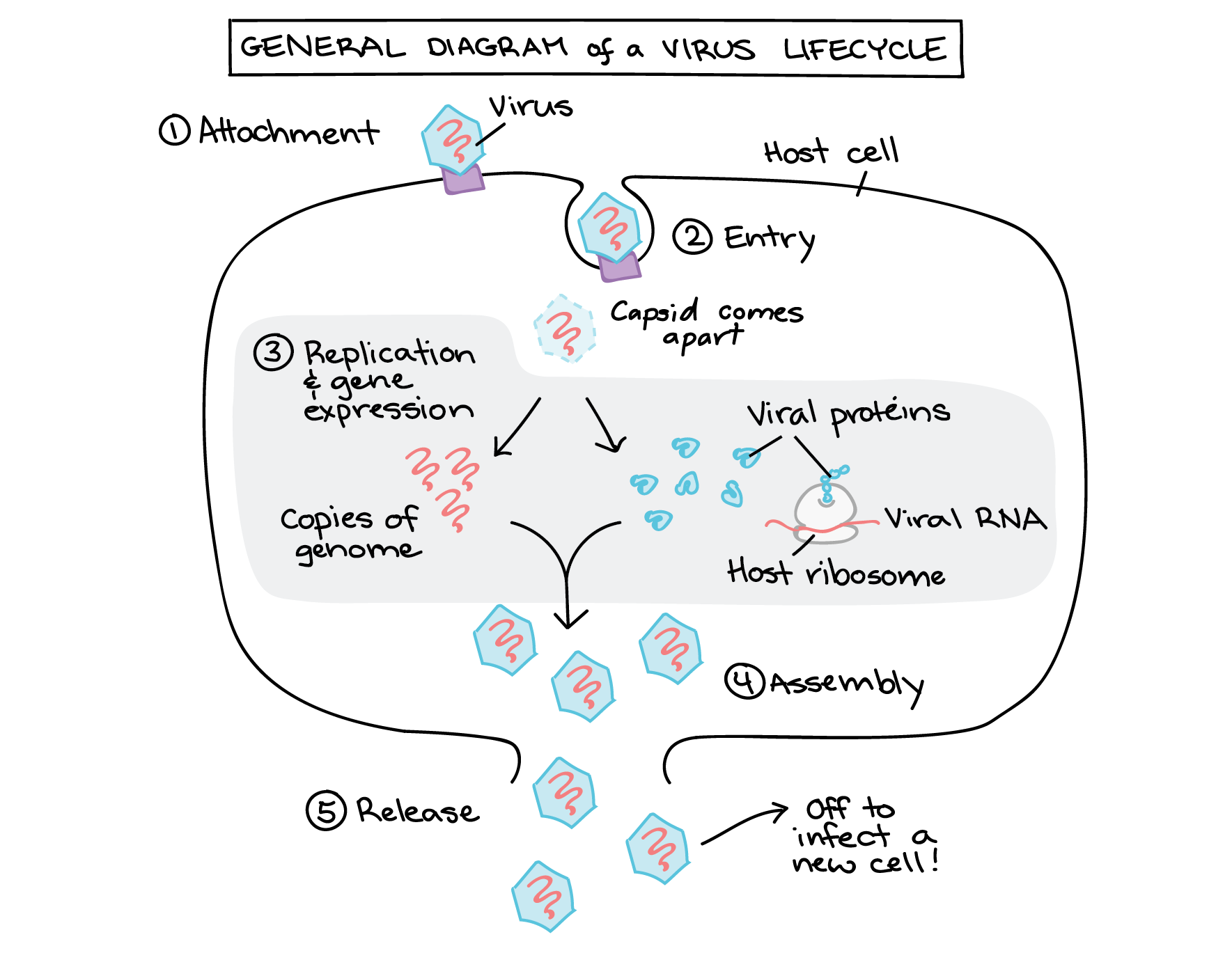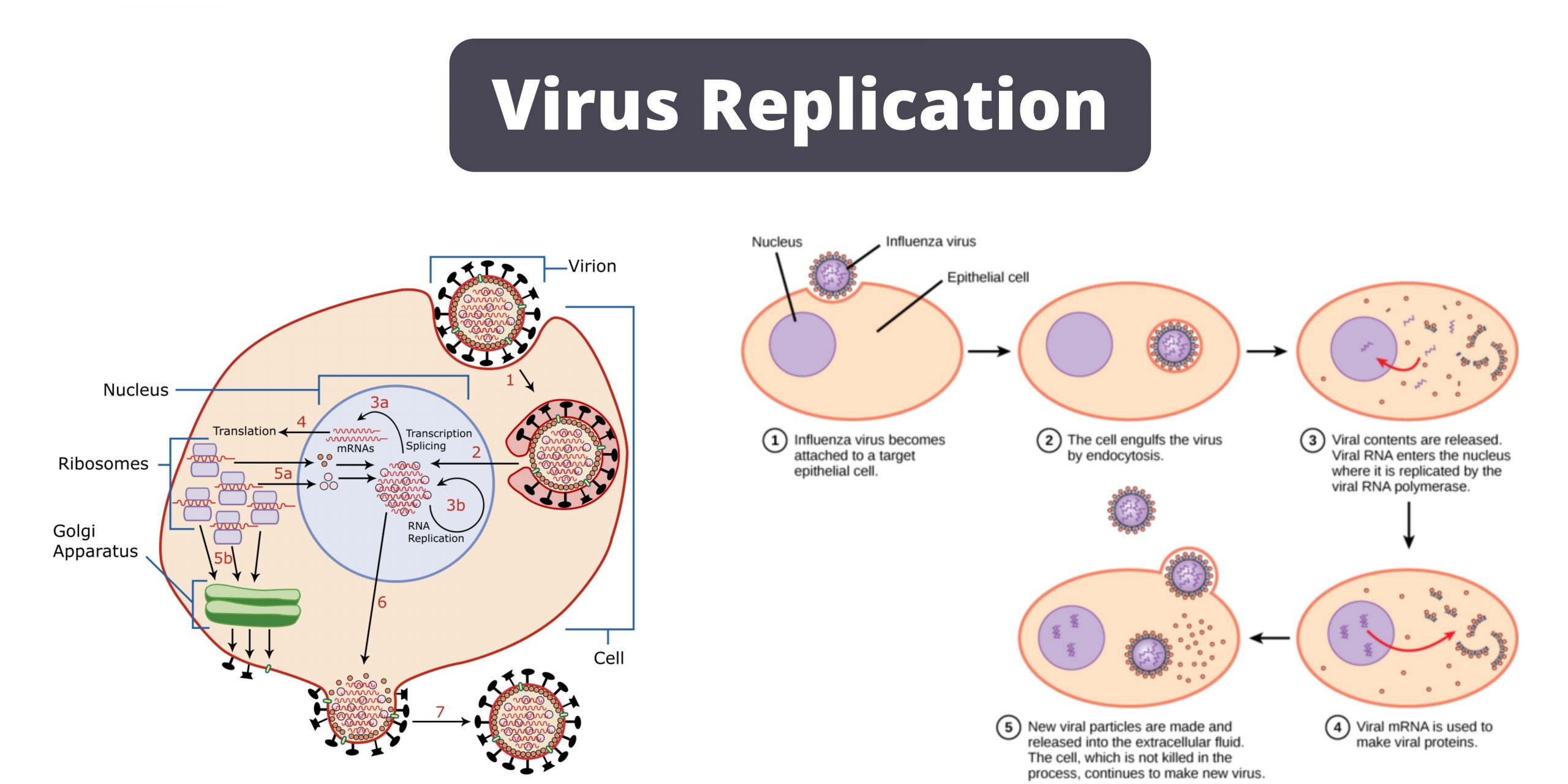Describe the Process of Viral Replication
The first step in the replication process is attachment. DNA Polymerase is the main enzyme in the replication process.

Virus Replication Advanced Read Biology Ck 12 Foundation
Viral replication site RNA viruses can contain ssRNA that can be directly read by the ribosomes to synthesize viral proteins.

. Assembly and Release Sixth and Seventh Steps Process involves bringing together newly formed genomic nucleic acid and structural proteins to form the nucleocapsid of the virus Nonenveloped viruses exhibit full maturation in the cytoplasm or nucleus with disintegration of cell Steps in Viral Replication. Start studying Describe the replication cycle of an animal virus. Upon entering the host cell the virus must accomplish two basic tasks.
Transcription of mRNA Late Transcription and then the formation of proteins called as late or structural proteins Late Translation. Adsorption - virus binds to the host cell. HIV Replication Cycle.
As it assembles and packages DNA into the phage head packaging occasionally makes a mistake. During the lytic cycle of viral replication the virus hijacks the host cell degrades the host chromosome and makes more viral genomes. Viral replication is simply the virus will infect a host cell insert its genomic info.
Replication of viral nucleic acid. How Viruses Infect Cells. Virus taken into cell by endocytosis or viral envelope fuses with host cell membrane and dumps content into host cell.
Replication of the viral genome and synthesis of viral structural proteins. A process called Adsorption. It is a biological polymerisation which proceeds in the sequence of initiation elongation and termination.
Penetration - virus injects its genome into host cell. During the process of viral replication a virus induces a living host cell to synthesize the essential components for the synthesis of new viral particles. Individual viral parts are assembled into a whole virus.
The type of the viral genome determines how the viral genome is replicated and expressed as viral proteins. This process is known as uncoating and allows the viral genome to directly access the host cells molecular machinery. The viral replication cycle can produce.
The virion RNA is converted to a double-stranded DNA form by the virion RT which uses a proline tRNA primer and carries a. After the viral genome has been uncoated transcription or translation of the viral genome is initiated. DNA Replication In the process of DNA replication the DNA makes multiple copies of itself.
It is this stage of viral replication that differs greatly between DNA and RNA viruses and viruses with opposite nucleic acid polarity. Replication of Viral Genome 5. These proteins are the components of daughter virion capsids.
In this process the viral genome is multiplied for the synthesis of new Virions. All RNA virus replication takes place within the cytoplasm EXCEPT the influenza virus. Viral Genome Replication - viral genome replicates using the.
A capsid containing the viruss genome and proteins then enters the cell. Assembly and Release Sixth and Seventh Steps Process involves bringing together newly formed genomic nucleic acid and structural proteins to form the nucleocapsid of the virus Nonenveloped viruses exhibit full maturation in the cytoplasm or nucleus with disintegration of cell Steps in Viral Replication. In animal cells virus replication is complete within several hours to at most a few days and results in the synthesis of 10 3 10 5 virions per cell.
Attachment of virus to outer surface of suitable host cell. View the full answer. Viruses must first get into the cell before viral replication can occur.
A virus attaches to a specific receptor site on the host cell membrane through attachment proteins in the. Virus replication proceeds following binding to specific host cell-surface receptors internalization and uncoating. Virus replication will be discussed in three stages.
The nucleic acid of bacteriophages enters. Replication between viruses is greatly varied and depends on the type of. The particles are then assembled into the correct structure and the newly formed virions escape from the cell to infect other cells.
Key Takeaways Steps of Virus Infections. Penetration of virus into host cell. The following points highlight the six main stages involved in the replication of animal viruses.
Once the genome is in the host cell the cell will read the info. Learn vocabulary terms and more with flashcards games and other study tools. A virus must use cell processes to replicate.
Because the composition and arrangement of the viral. Initiation of infection genome replication and expression and finally egress or release of mature virions from the infected cell. The process beginning with entry of the virus into the host cell to the release of progeny viruses is referred to as the replication cycle.
Steps in Viral Replication. During the lytic cycle of viral replication the virus hijacks the host cell degrades the host chromosome and makes more viral genomes. 1 early events attachment to susceptible cells penetration and uncoating 2 viral biosynthetic events replication of the viral genome transcription and translation and 3.
Through the generation of abundant copies of its genome and packaging these copies the virus continues infecting new hosts. Although the specific detail of virus replication vary from one virus to another general replication is same for most virus. Viral genes are copied within minutes and mass produced into viral parts.
Synthesis and Assembly of Virus Capsids 6. The shell of the capsid disintegrates and the HIV protein called reverse transcriptase transcribes the viral RNA into DNA. This infographic illustrates the HIV replication cycle which begins when HIV fuses with the surface of the host cell.
Steps in Viral Replication. As it assembles and packages DNA into the phage head packaging occasionally makes a mistake. The replication cycle of all viruses involves three key phases.
Viral replication is the formation of biological viruses during the infection process in the target host cells. It is an enzyme-catalysed reaction. Solution for Describe the viral replication process and the resulting type of Growth curve.
Release of New Virus. The basic process of viral infection and virus replication occurs in 6 main steps.

Viral Replication Boundless Microbiology

Schematic View Of A Virus Replication Cycle For A Detailed Description Download Scientific Diagram

The Viral Life Cycle Microbiology

Entry Assembly And Budding Processes Of Enveloped Viruses Some Download Scientific Diagram

Chapter 17 2 Concepts Part 3 Animal Virus Replication Diagram Quizlet

The Viral Life Cycle Microbiology

Virus Replication British Society For Immunology

Virus Structure And Replication

Virus Structure And Replication

Intro To Viruses Article Viruses Khan Academy

Viral Replication Cycle In Eukaryotic Cells The Virus Binds To A Download Scientific Diagram

Viral Replication Cycle Definition Steps Mechanisms

Viral Replication Boundless Microbiology

Dsrna Replication Transcription Viralzone

The Viral Life Cycle Microbiology
12 1 Viruses Concepts Of Biology 1st Canadian Edition

Schematic Representation Of The Replication Cycle Of Iav The Viral Ha Download Scientific Diagram

Schematic Of Positive Sense Rna Virus Replication Cycle General Steps Download Scientific Diagram
Comments
Post a Comment